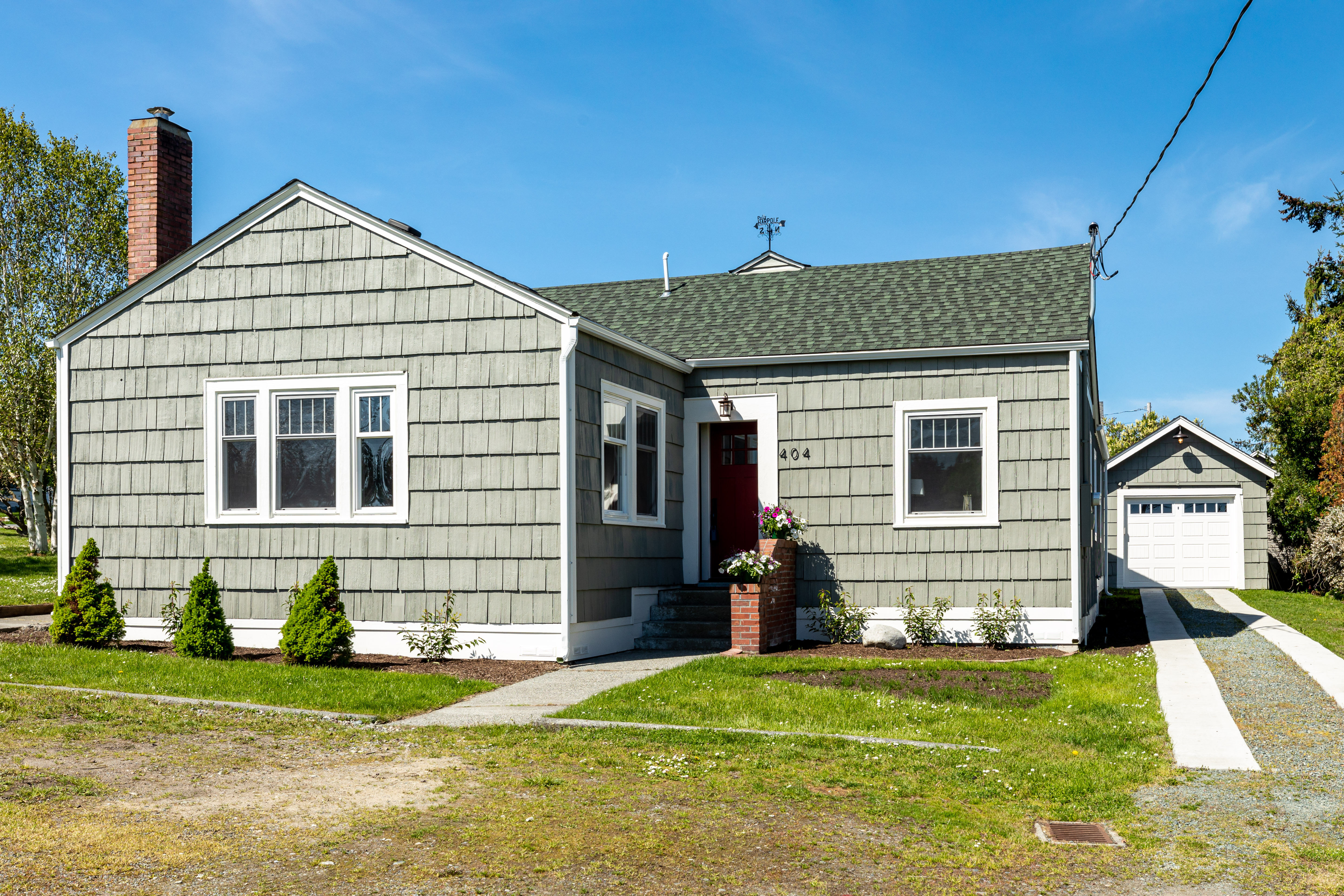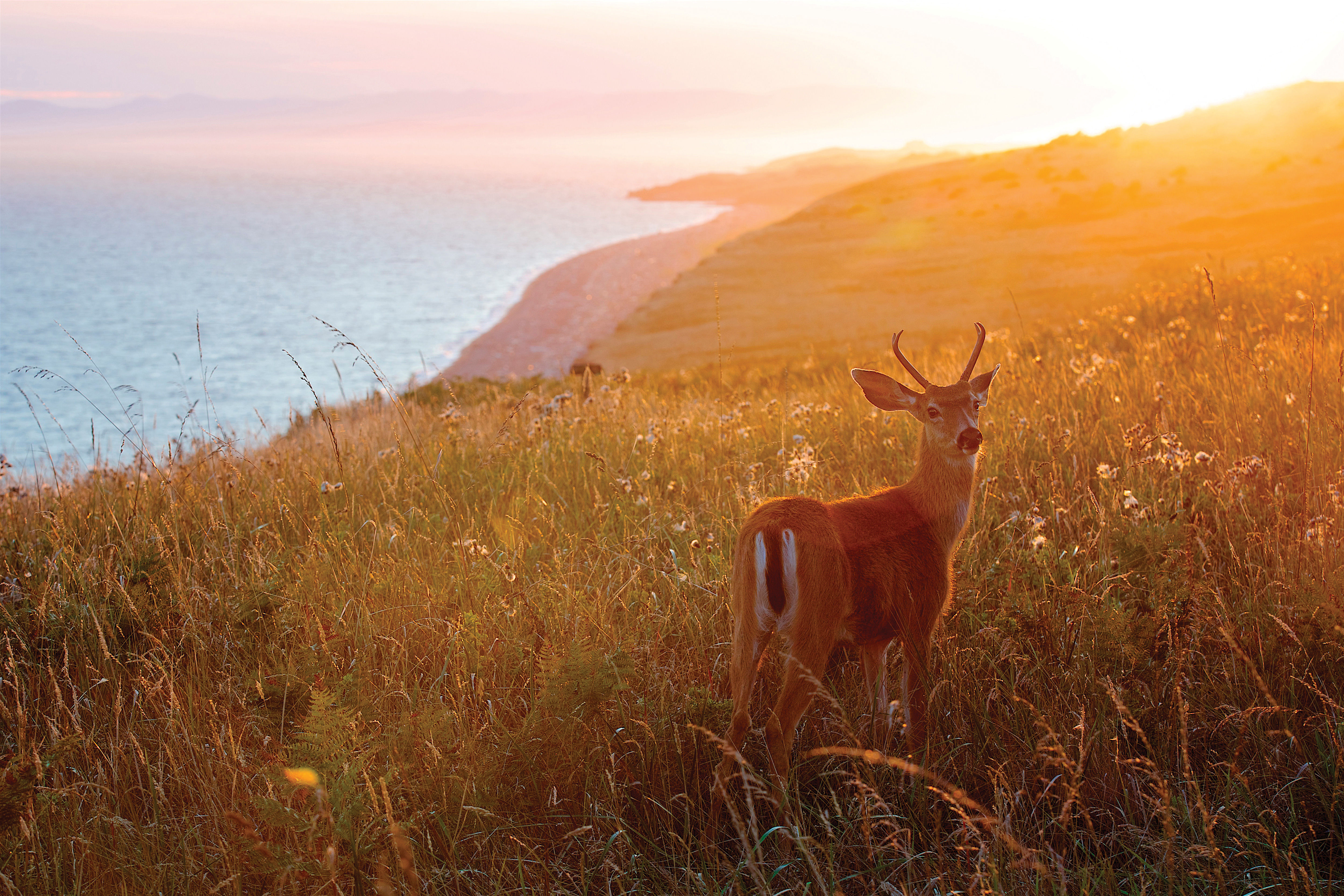
Where to Stay and What to Do on Washington's Idyllic San Juan Islands (and Beyond)
Photo by Evgeny Vasenev / Cavan Images.
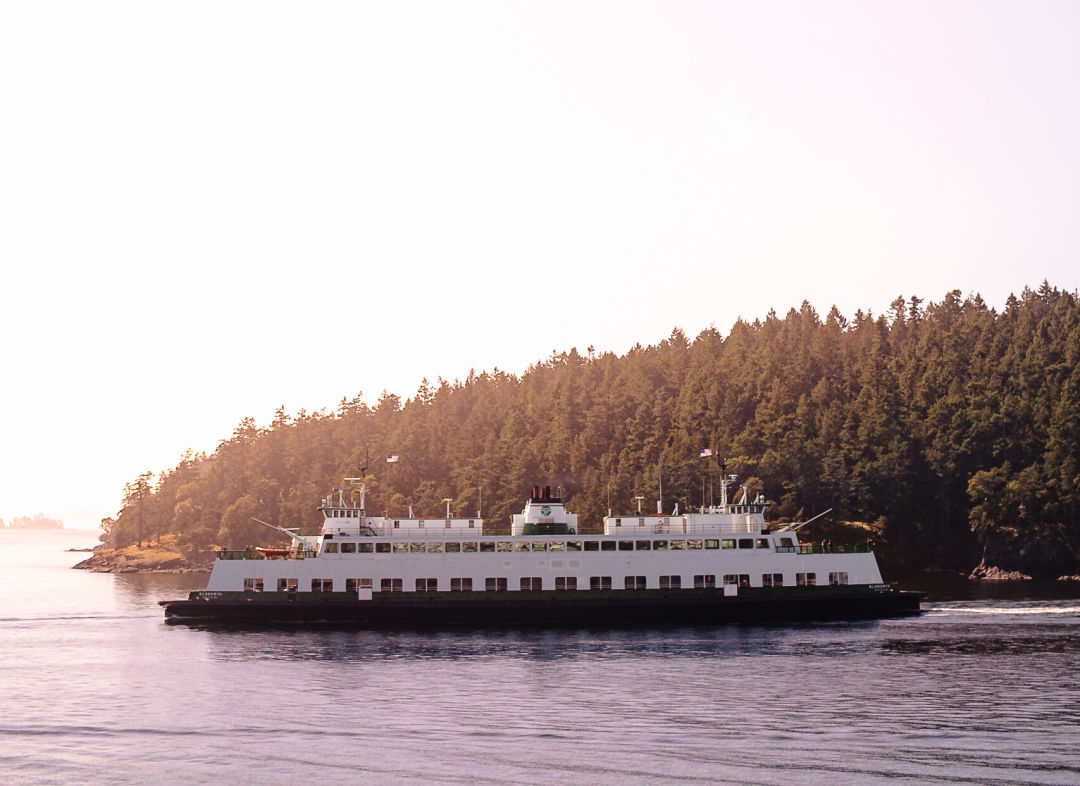
The Washington State Ferries are the lifeline that connects the San Juan Islands.
Image: Joe Tobiason
Zero is a huge number. Especially when counting Covid: As of press time San Juan County has seen absolutely no loss of life due to the virus and only a half-dozen hospitalizations. Even in the pandemic, the San Juan Islands feel a little magical.
How did one of the biggest tourist destinations in the Northwest manage such a feat? The very isolation that draws visitors to the circular archipelago worked in its favor when reduced ferry trips exacerbated the already tricky process of traveling here. Even as the islands’ Airbnbs filled to capacity, the lack of crowded indoor spaces discouraged community spread. Hence the San Juan miracle.
Though the islands sit squarely atop Puget Sound, they have always felt set apart. A Spanish explorer bestowed the moniker of San Juan on this cluster back in the eighteenth century; early timber and extraction industries have since faded as tourism has taken over. Only the largest islands get state ferry service, shielding most millionaire (and billionaire) homeowners from public view.
And so, on the San Juan Islands—and their sisters Camano and Whidbey, which benefit from bridge links to the mainland—the leisurely island pace endures. It’s easy to achieve when everything is either five minutes or a why-bother ferry ride away. Serenity still rules in the misty mornings on rural farms, along the dark waters of the Salish Sea dotted with whales and herons. For once, we treasure what the San Juans lack as much as what they give us.
Jump to an Island:
San Juan Island / Lopez Island
Orcas Island / Whidbey & Camano Islands
San Juan Island
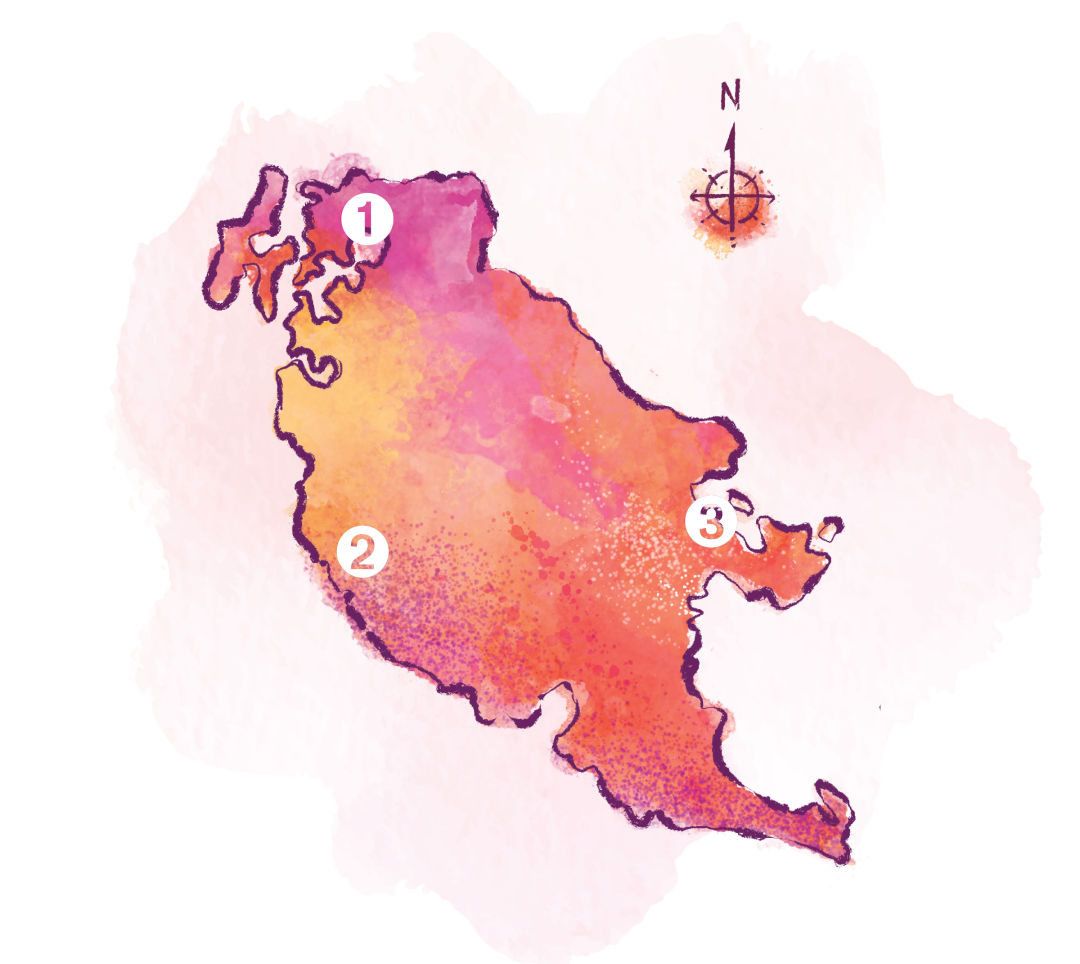
Essentials
1. Roche Harbor
When the swinging waterfront resort lights up at night, historic Hotel de Haro at its center, the enclave glows with bygone charm. On summer days the crowd of cabins, marinas, and tourists can overwhelm.
2. Lime Kiln Point State Park
Hard to imagine that the bucolic western coast of the island was once devoted to mining limestone and firing it in kilns to produce a material used as mortar; today the stout lighthouse and rugged shoreline make for good sunset and whale watching.
3. The Whale Museum
Southern residents earn center stage in the funky downtown exhibit space, from hydrophone recordings to a rearticulated orca skeleton; Insta-ready murals adorn the building’s exterior.
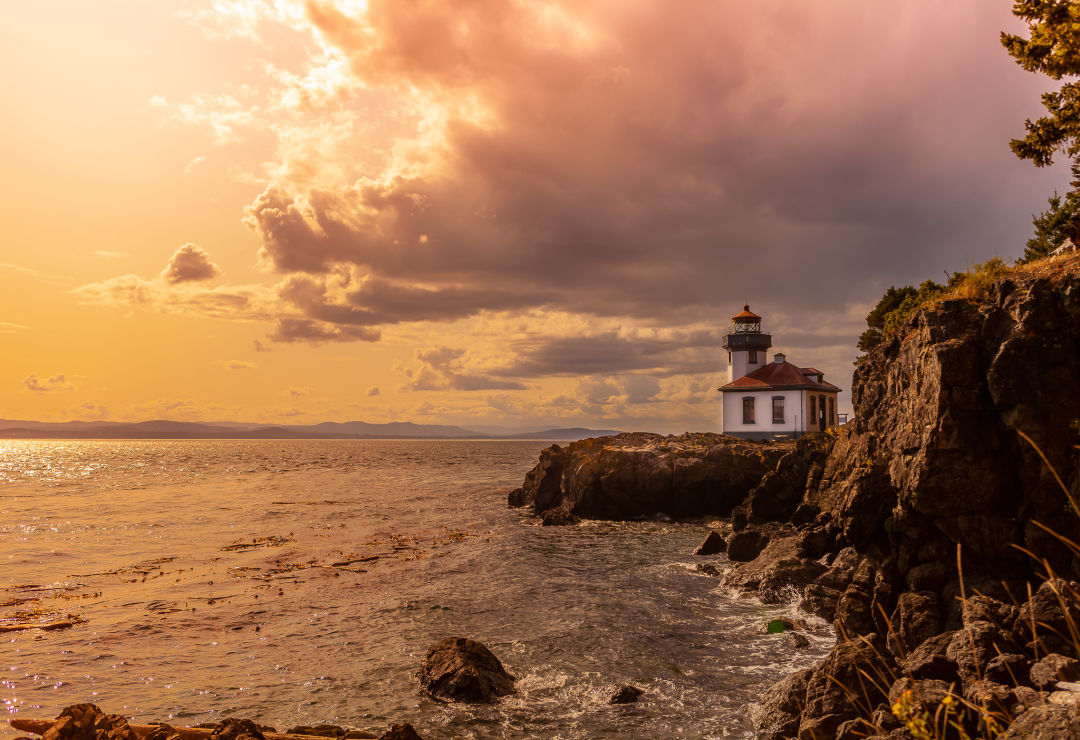
Lime Kiln State Park makes for excellent sunset viewing.
A Whole Other Kettle of Blackfish
New rules protect the orcas who live in the San Juans—but local guides argue the whale-watching seascape has completely changed.
One thing everyone agrees on: The southern resident killer whales are ghosting us. The Salish Sea’s signature swimmers have a good reason—the reduced volume of chinook salmon, most scientists agree, has led the southern residents to spend more time out in the Pacific Ocean. But that doesn’t mean killer whales have vacated Puget Sound.
“This is the best whale watching in North America, possibly in the world,” says Brian Goodremont, who leads tours out of Friday Harbor, where one of his San Juan Safaris boats is anchored next to the ferry terminal. He still sees whales on almost every trip, but over the last few years the orcas have mostly been Bigg’s killer whales, a separate ecotype also called transients. Same species, but they eat mammals like seals and porpoises rather than salmon. “‘Transient’ presupposes that this is not their home,” Goodremont says. “Nothing is further from the truth. They are just as resident to the area as the southern residents.”
Still, the SRKWs remain the hometown favorites. “There’s a real emotional aspect to it,” says Katie Jones of the Center for Whale Research. As a literal sea change turned public opinion against aquarium shows and captive whales (buoyed by the twin cinematic pillars of Free Willy and Blackfish), the wild southern residents became beloved icons. Ones often tailed, at a distance, by whale watchers.
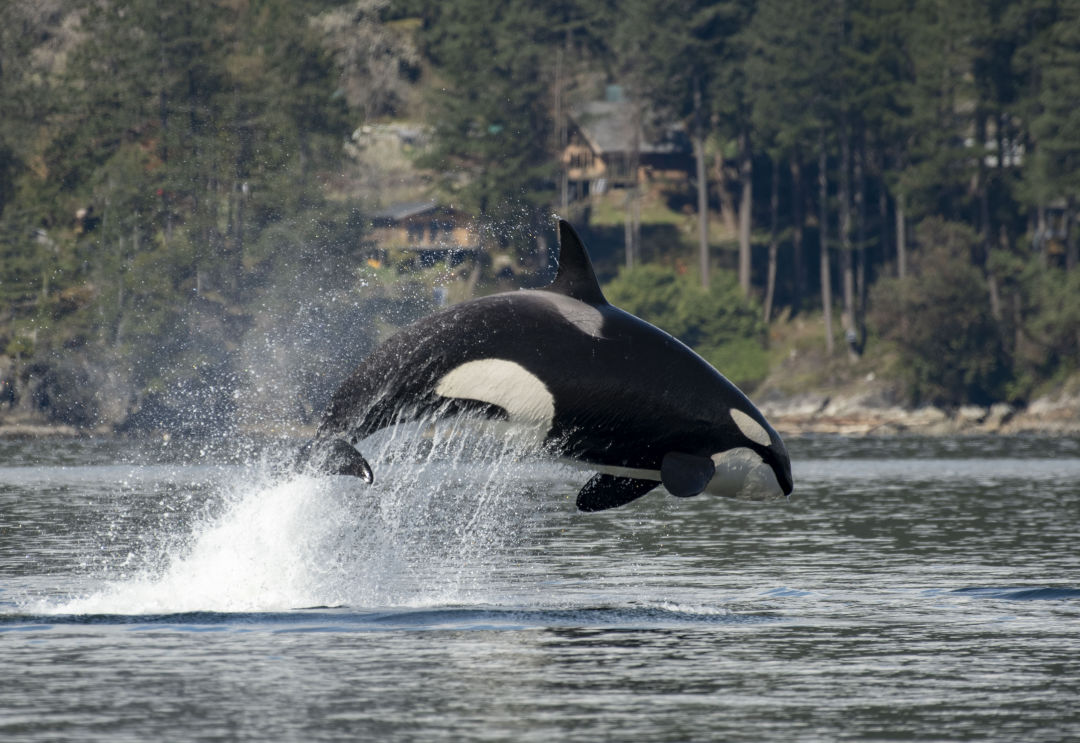
A Bigg’s killer whale leaps along the coast of San Juan Island.
But as the population dipped—today only 75 southern residents remain—governor Jay Inslee formed a task force in 2018 to address species recovery. Besides recommendations to boost salmon production and eliminate Puget Sound contaminants, the task force prompted a licensing system for whale watchers and rules that keep commercial vessels at least 300 yards from the animals in summer.
The southern residents will be a hard act to follow; they vocalize more than their Bigg’s cousins, travel in more consistent groups, and more often breach the surface during hunts or play. Big changes to their salmon food source could be decades away, even with major moves like dam removals. So the new kids in town, the Bigg’s transients, may become increasingly familiar.
Goodremont estimates he’s spent 2,500 days on the water with Puget Sound’s wildlife since 1998. He applied for his license but emphasizes that the SRKWs, or even the Bigg’s orcas, aren’t the whole story of the Salish Sea. These days the waters run with minke, fin, and grays—even a sperm whale once. “All people hear is negative [news],” he says. “That’s not what this area is all about.”
Kelley Balcomb-Bartok of the Pacific Whale Watch Association, son of famed orca expert Ken Balcomb agrees. “Humpbacks weren’t here 20 years ago. We used to barely see Bigg’s,” he says. “There have never been more whales around here.”
Friday Alfresco
Where to dine outside in Friday Harbor.
Even as travelers return to the San Juan Islands, Covid precautions remain strict—but mild summertime temperatures make for plentiful outdoor dining. Longtime downtown anchor Downriggers sports a deck overlooking the ferry terminal—more scenic than it sounds—for signature fish and chips with cocktails. Outdoor tables at Friday Harbor House get so much sun that brunch can double as a vitamin D supplement. Inland, giant retractable garage doors make the indoor seating at San Juan Brewing Company almost as airy as the open yard, and nearby Bakery San Juan slices bubbly, light sourdough pizza for a mobile snack.
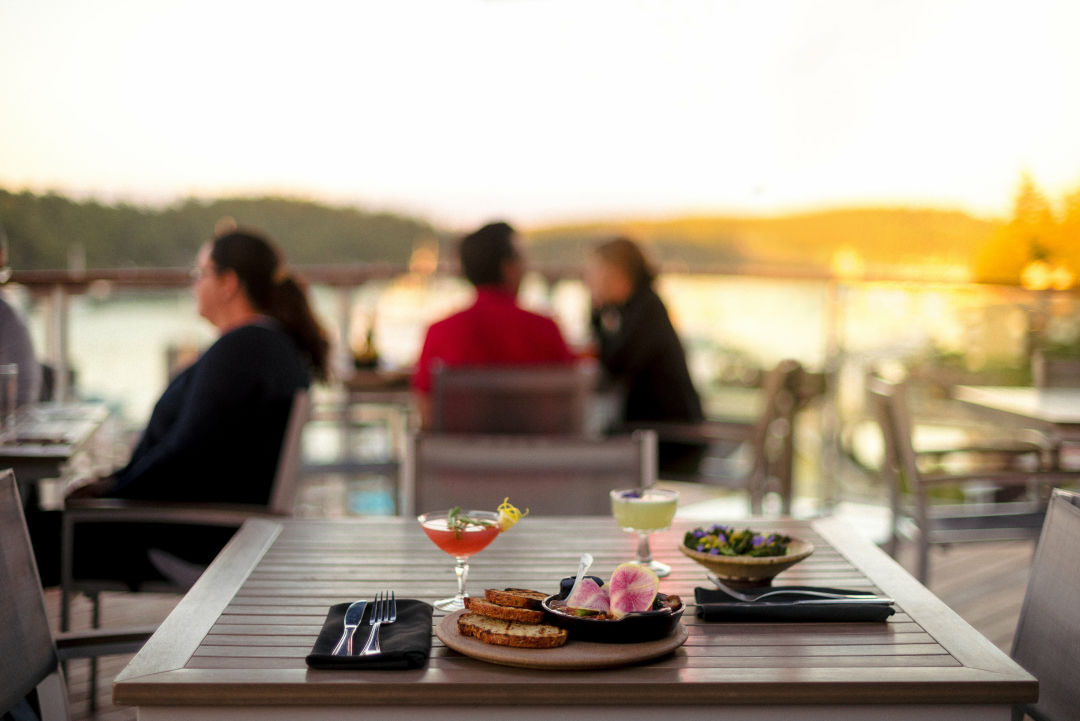
A bouquet of a meal at Friday Harbor House.
A Salute to American Camp
The two sides of San Juan Islands National Historical Park are at war—or at least they were once. Both plots of land represent onetime military headquarters: English Camp sits on secluded Garrison Bay at the top of San Juan, while American Camp takes up most of the dramatic southern hook of the island where beaches line a swath of open grassland, the snowy peaks of the Olympic Mountains visible in the distance. Together, they form the only national park on the islands. This summer a spiffy new visitor center opens in American Camp, partially to commemorate the slightly farcical Pig War of 1859, in which no one died (except the poor pig). American and British forces both occupied the island until it was definitively handed to the U.S. in 1872. nps.gov/sajh
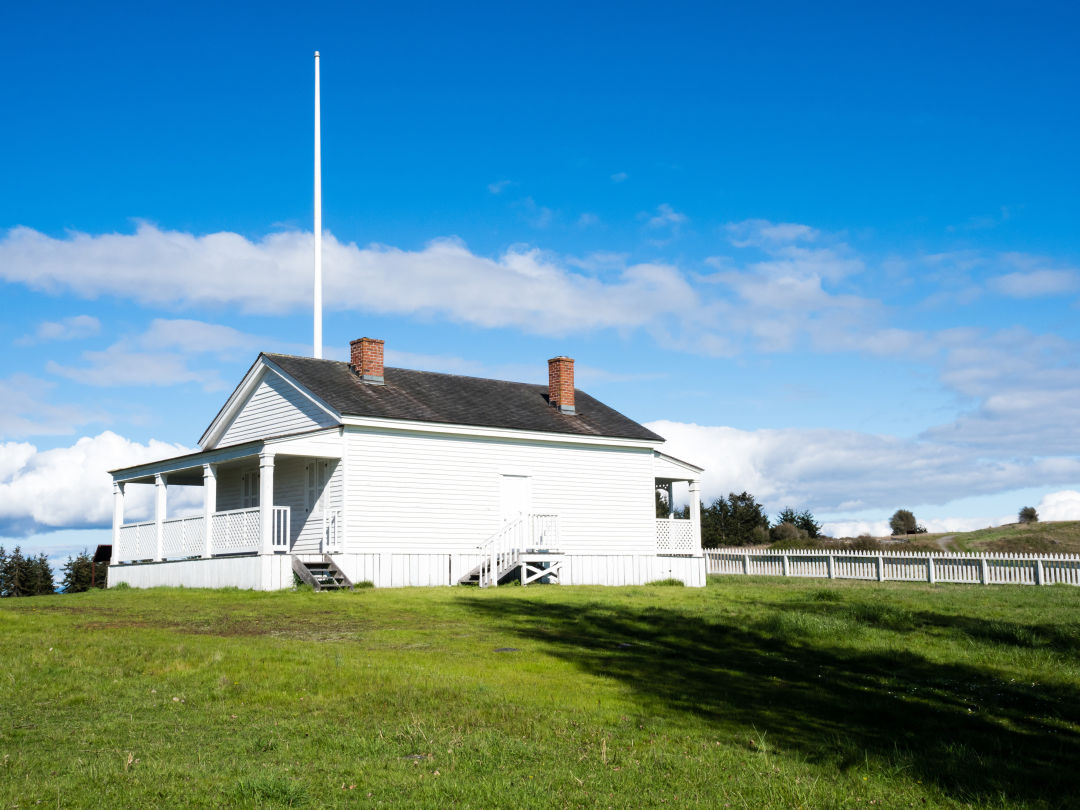
Historic quarters at American Camp.
Image: shutterstock by Amehime
Lopez Island
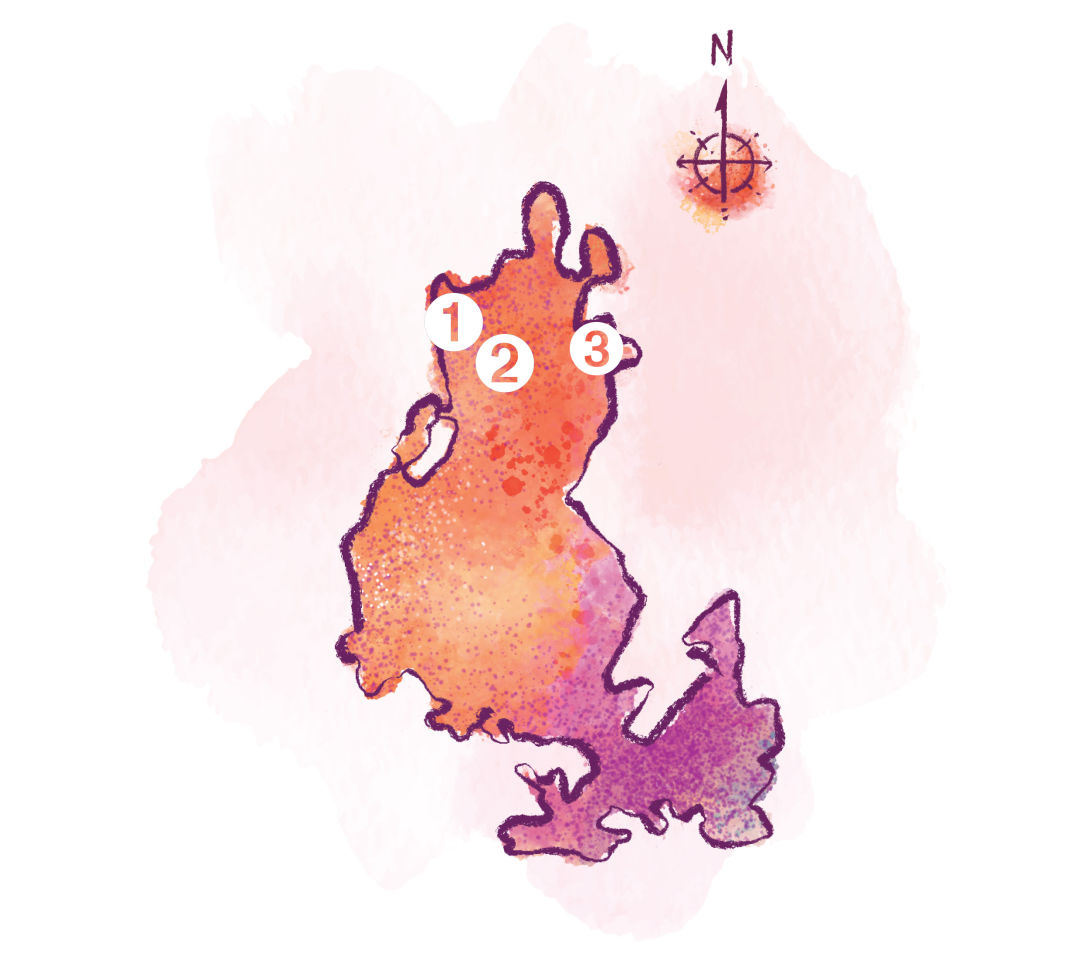
Essentials
1. Ursa Minor
Lopez’s signature farms provide almost every ingredient at this restaurant, whose relaxed, wisteria-trimmed dining room turned the sleepy island into a destination dining spot.
2. Village Cycles
With little elevation gain and traffic, Lopez boasts the best—or at least easiest—cycling in the San Juans. This longtime bike shop will deliver regular and electric rentals to the ferry terminal.
3. Spencer Spit State Park
A campground offers easy access to the beach and a calm lagoon for seasonal crabbing and clamming, plus a group site with an eight-bunk shelter.
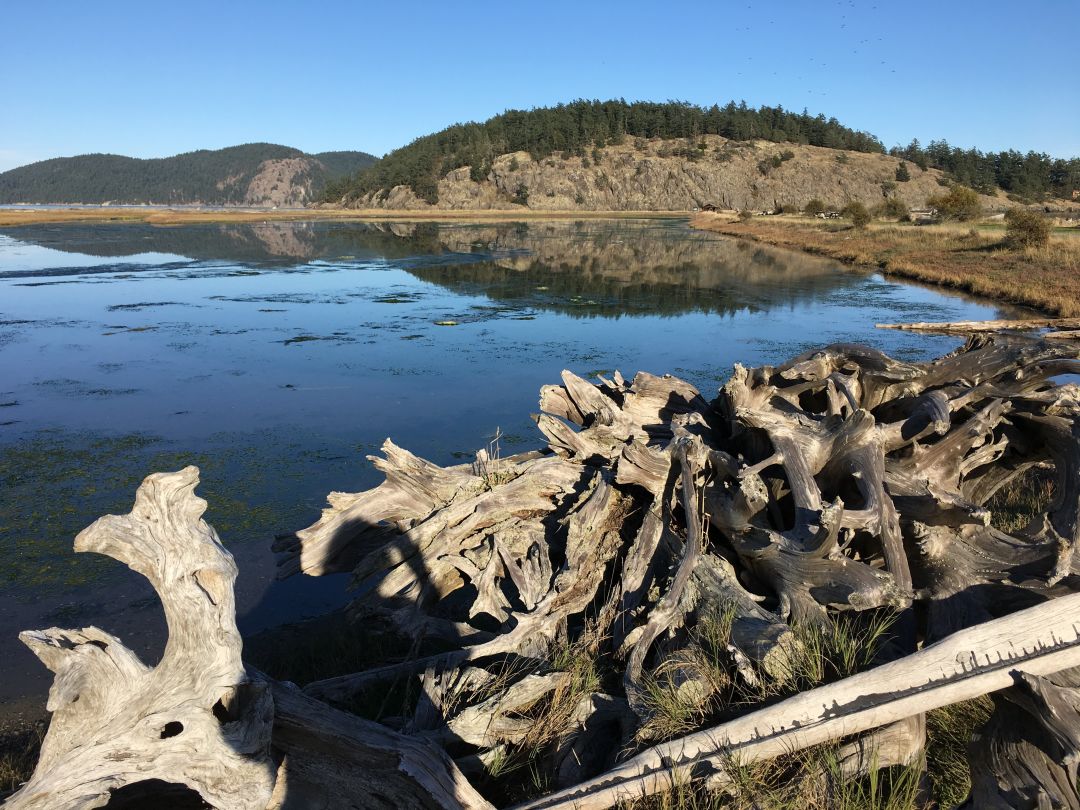
Spencer Spit State Park offers a calm shoreline.
Barn Owl Comes Home to Roost
Two Lopez bakers graduate from a 200-square-foot bakery to a reimagined old art colony.
The eight years Nathan Hodges and wife, Sage Dilts, spent baking in a postage-stamp space suited the notoriously unhurried Lopez Island—but the pair was more than ready to upgrade in 2019 when they purchased Grayling Farms in the center of the rural island. Built as a lumber barn and sawmill, the main structure also served as a hardware store and art colony before falling into disrepair. Now Hodges and Dilts bake their Barn Owl rustic bread loaves and hearty pastries, all leavened with their personal sourdough culture, with room to breathe.
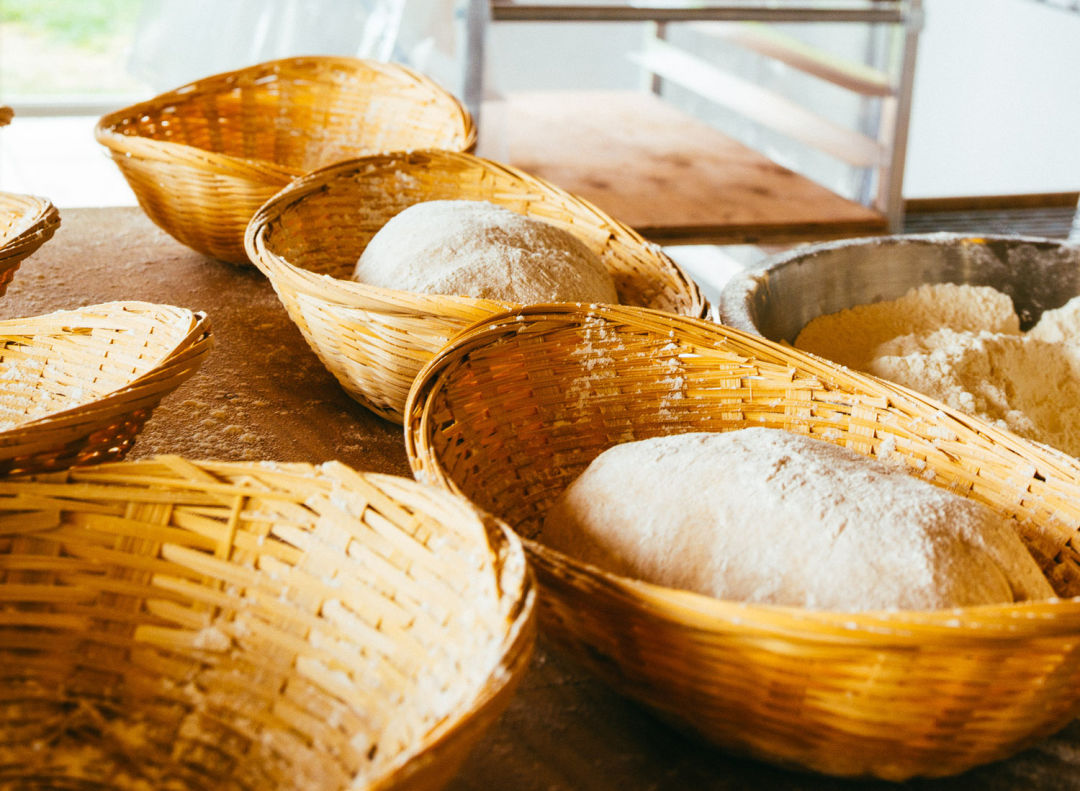
Barn Owl bakes its fresh wares on Lopez Island.
Image: Adam Nash
Though Lopez markets sell Barn Owl breads, locals can purchase from the on-your-honor farm stand out front. Eventually, Hodges hopes visitors can sign up to visit the second-floor art gallery in the rehabbed farm building, which displays treasures found during renovation. (Though they returned artworks to the original makers when they could.)
“It’s a great, big old wooden boat of a building,” he says cheerfully; the couple now lives within it, along with their brand-new Italian wood-burning oven (it beats the old one they built themselves). Island farmers grow their heritage grains, one using horse-drawn equipment, and another local partner mills it with historic tools. This veritable production line of anachronism—all for a bakery on a mission to protect and celebrate ancient heirloom grains—feels right for the boxy old building. “It’s a one-of-a-kind thing,” says Hodges. “No one in their right mind would build it today.” barnowlbakery.com
Orcas Island
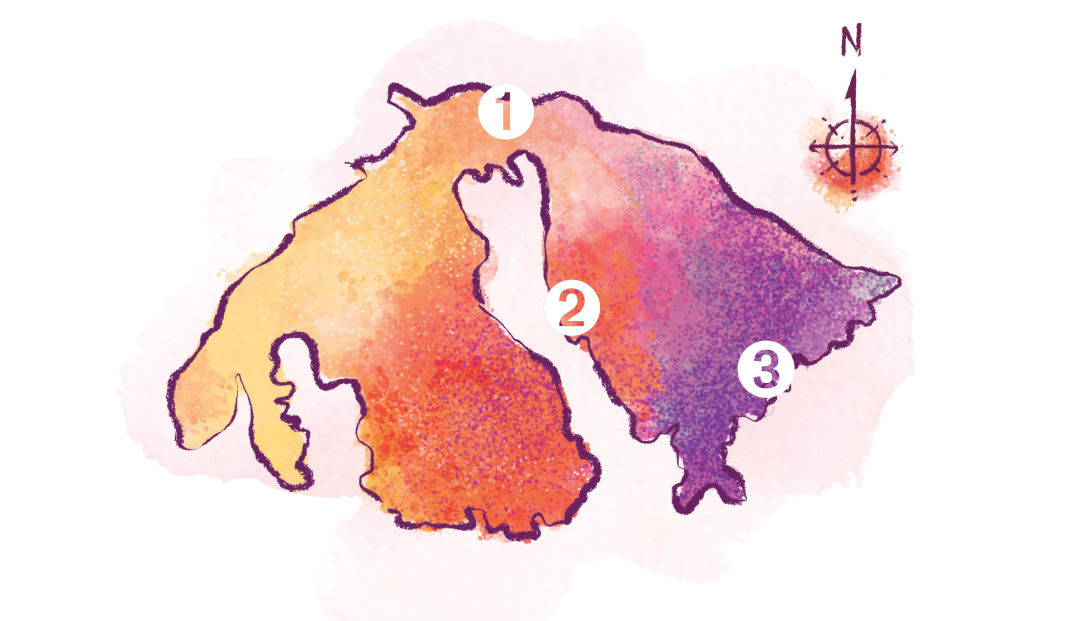
Essentials
1. Hogstone’s Wood Oven/Ælder
Chef Jay Blackinton does double duty in a single rustic building, dishing Neapolitan pizzas at the Hogstone half of the restaurant while serving tasting-menu high cuisine at Ælder.
2. Rosario Resort and Spa
When the historic mansion became a hotel, it retained all the best eccentricities—the basement pool, a second-floor pipe organ, and, reportedly, the ghost of the millionaire owner’s daughter.
3. Doe Bay Resort and Retreat
The hippie streak that runs through the out-of-the-way resort fuels an annual music fest and year-round chill around the cabins, soaking tubs, swim beaches, and veggie-minded restaurant.
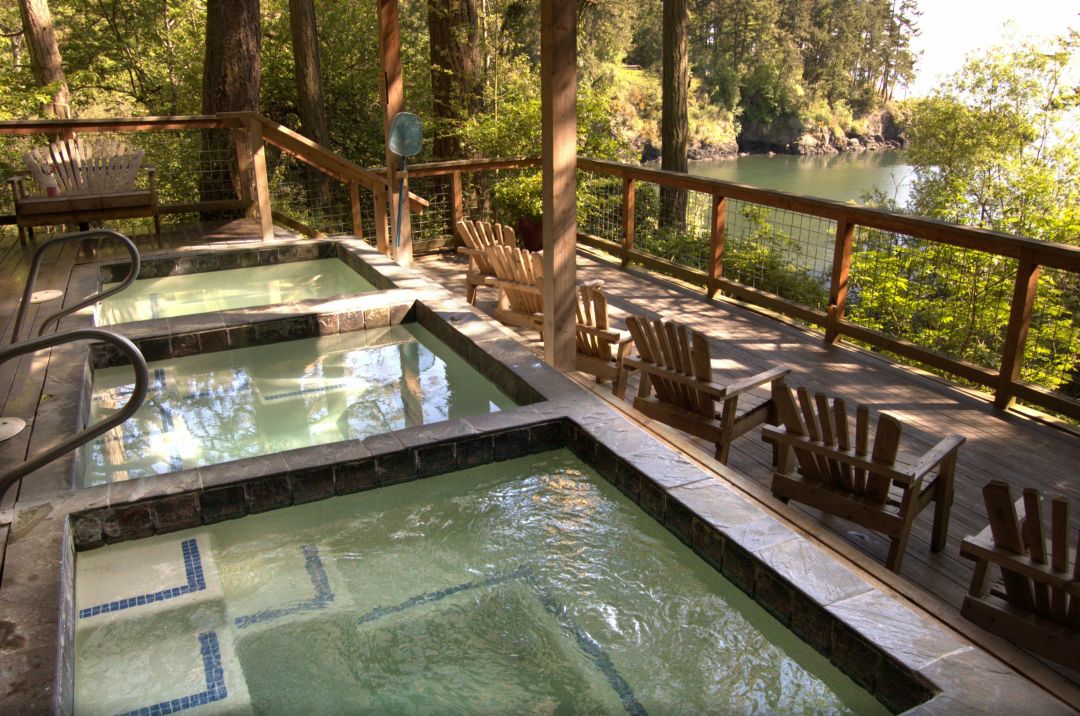
Doe Bay Resort's spa tubs offer a soak with a view.
The State of Moran State Park
How do you end up with a park that preserves a mountain, five lakes, acres of old-growth forest, and almost 40 miles of hiking trails—all within an island two-thirds the size of the city of Seattle? It helps when one of the first major landowners idolizes John Muir. In 1905 Robert Moran, Seattle mayor during the Great Fire and a Klondike Gold Rush shipbuilder, took an early retirement to Orcas Island, buying up almost 5,000 acres and erecting a mansion that is now the private Rosario Resort. His acquaintance with famous preservationist Muir eventually led Moran to donate most of that land to the state.
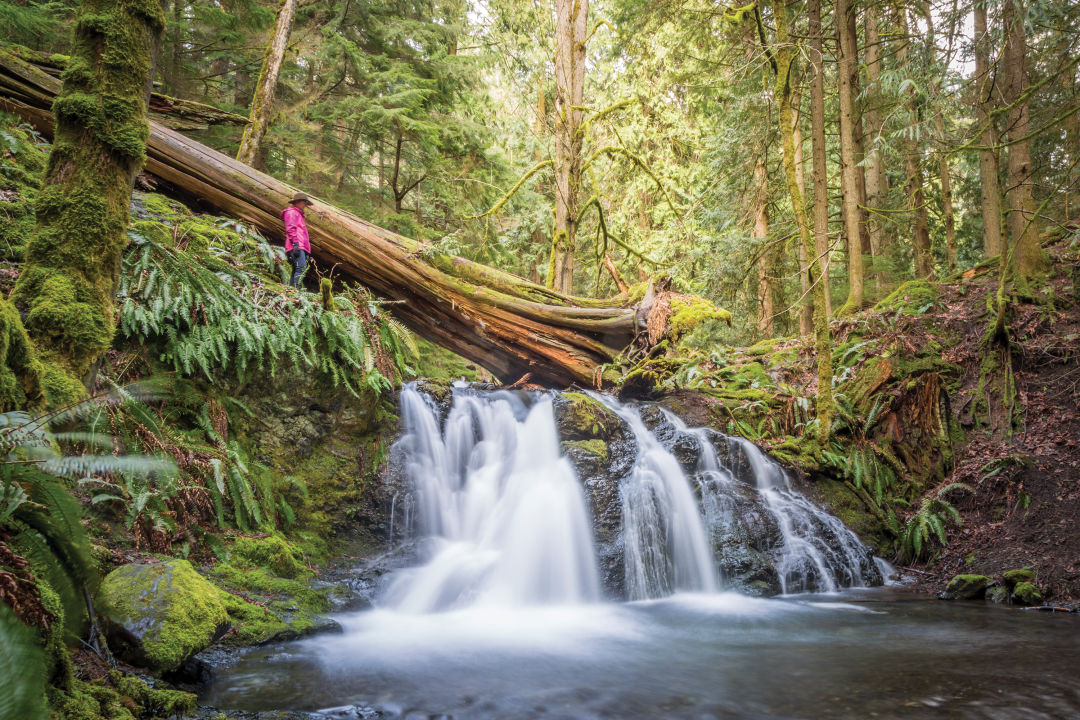
Rustic Falls in Moran State Park.
Image: Tandemstock by paul hamill
Moran State Park celebrates its 100th year in 2021, its main gift a brand-new visitor center atop the crown jewel of the park, Mount Constitution. Moran built a wagon road up to the peak’s 2,400-foot summit, which led to today’s easy auto access. The New Deal’s Citizen Conservation Corps constructed a castle-like lookout on top, and on clear days the view stretches from Canada to the Cascades. Signature arches guard either end of the park; Moran himself affixed a plaque on one, noting the land was dedicated by him “for your pleasure and care.” The only rules stated: “No killing or fires.”
In Bloom on Orcas
What’s new on the San Juans’ biggest island.
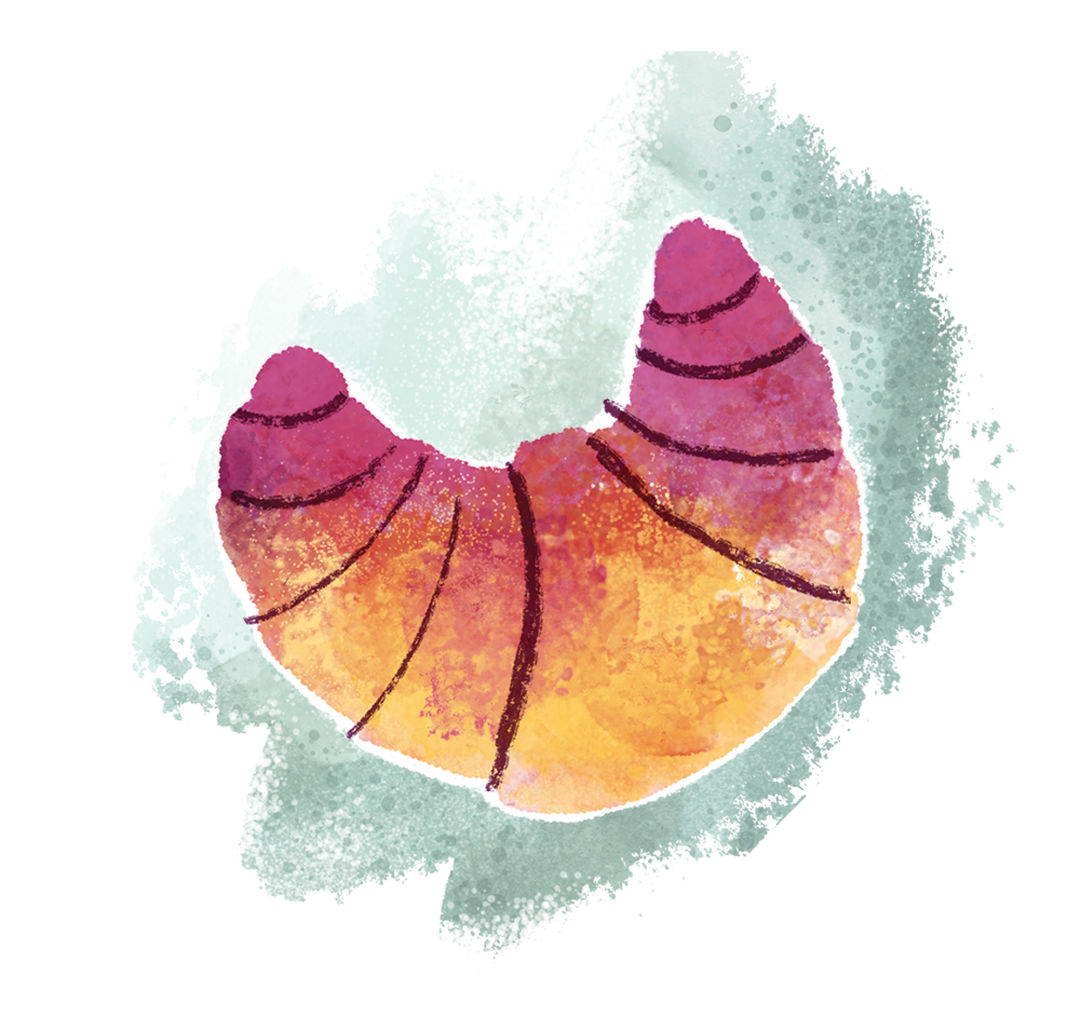
Seabird Bakeshop: The popup from baker Brea Curry sells brioche tarts and elaborate doughnuts at the Orcas Island Farmers Market, plus she sends boxes to subscribers in a community pastry share.
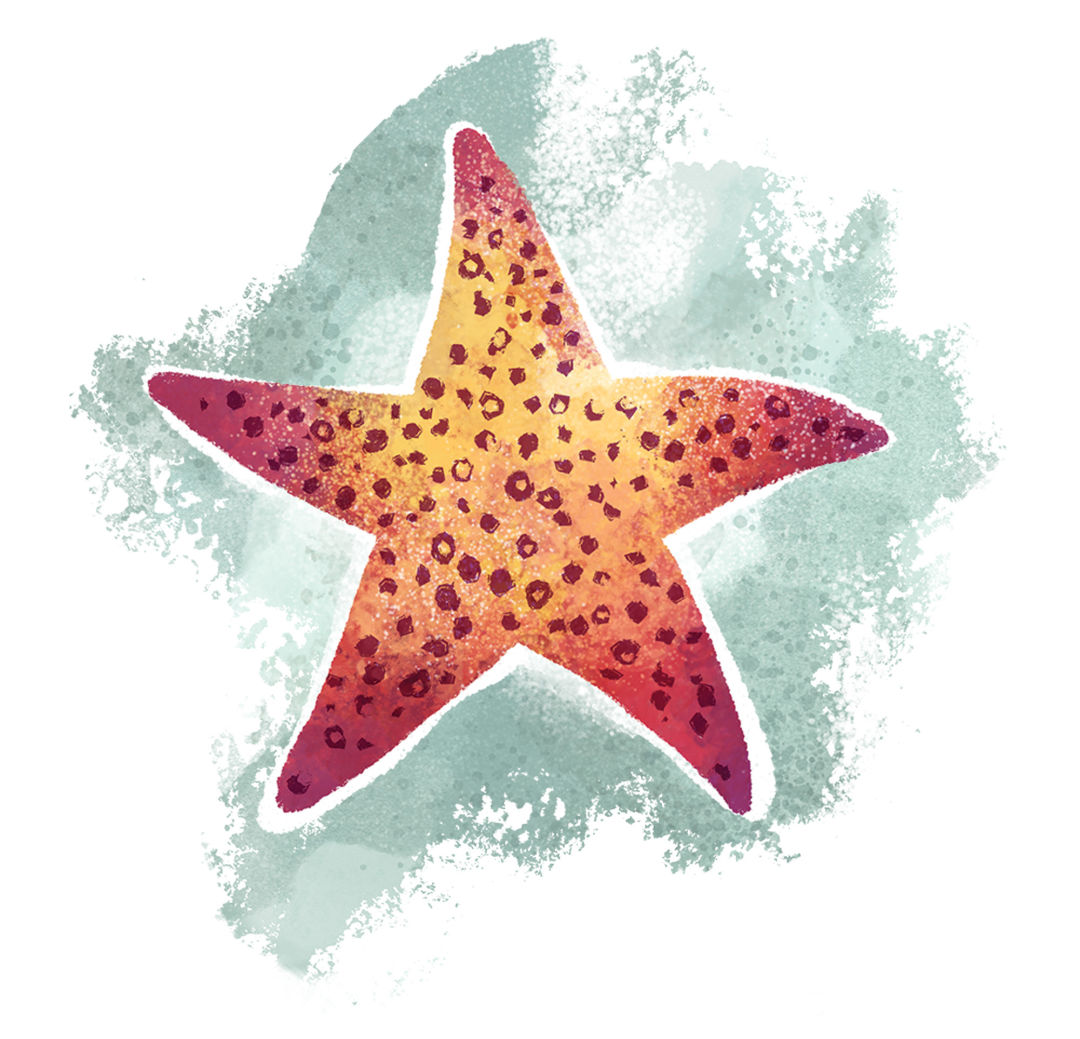
Outlook Inn Waterfront Suites: The farmhouse-style Eastsound hotel built five ultra-modern suites across the street in 2019, their patios jutting over the seawall onto the public beach.
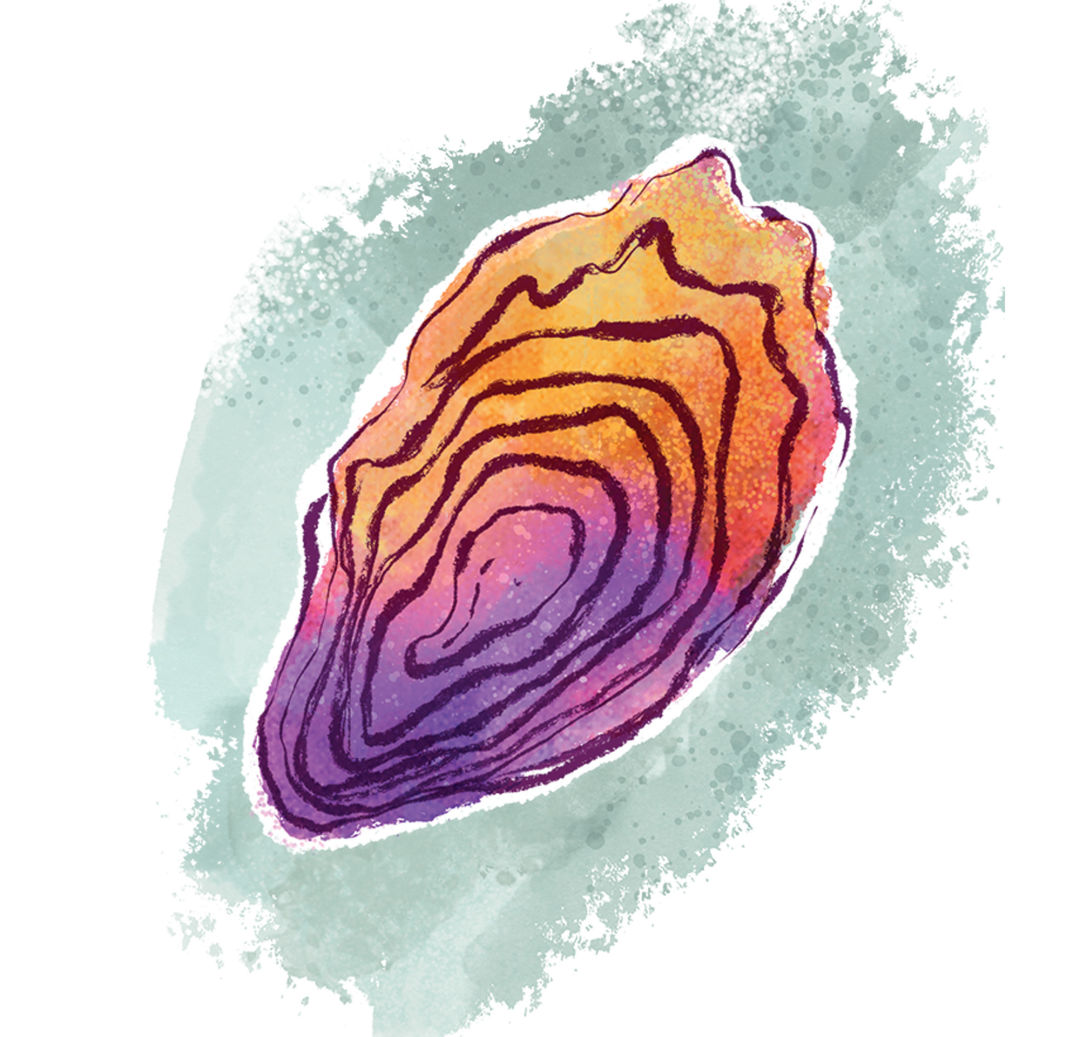
Buck Bay Shellfish Farm: Though the shop still sells fresh oysters grown in the shallow water outside, the bay-front farm’s new bistro steams a two-pound whole dungeness crab or fries halibut fish and chips.
Island Grown
Two best friends return home to put down Roots.
Within minutes of meeting them, both Shea Sasan and Cole Sisson pull out their phones to show off photos of the pair as children, two wide-eyed youngsters raised here on Orcas. The bond they forged back in that era of oversized T-shirts and frosted tips never faded, though both left the island as young adults—Sasan to work in luxury hospitality in Orange County, Sisson to run the Bellagio’s wine program in Las Vegas. Even as they show off the digitized versions of old snapshots, they recognize how unusual it is to have returned. “Not a lot of people come back to open a business,” says Sisson. “The average age here is 59 and a half.”
We stand in the empty shell of what will become Roots Orcas Island, a wine bar and cafe at the main intersection in Eastsound, the biggest and only real town on the island. The owners rattle off what they hope to provide by this summer’s opening: charcuterie, wine flights, espresso, maybe grain bowls or poke. A tiny marketplace of fine foods, perhaps sandwiches and salads. An outdoor patio, a space for guest chefs to hold popups.
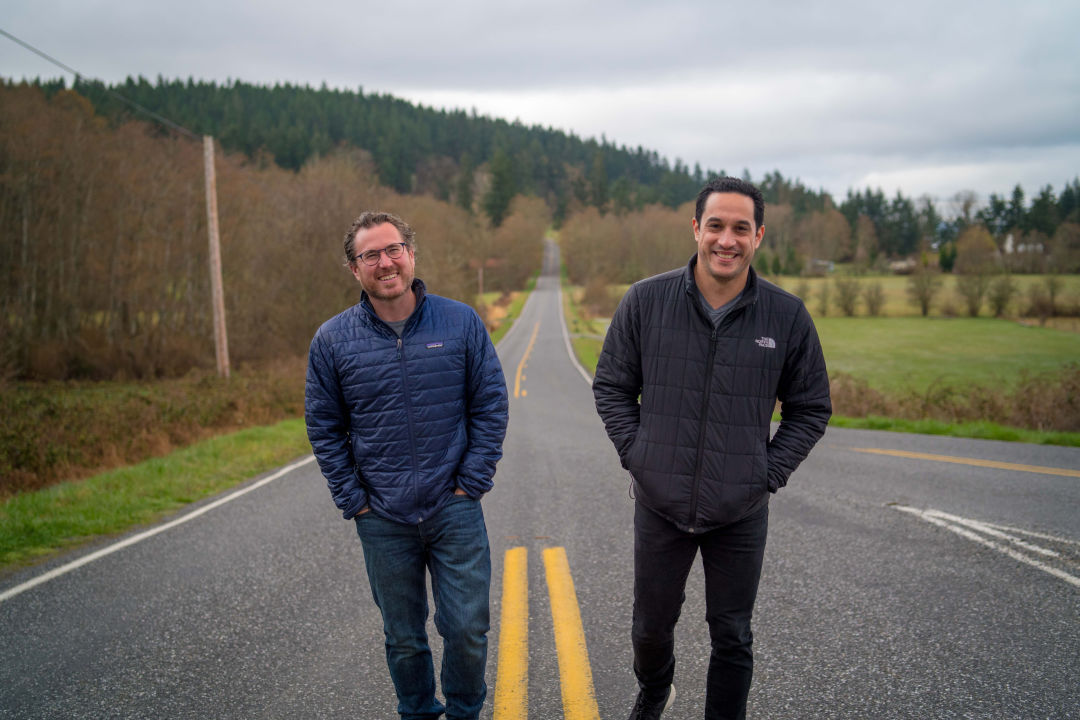
Cole Sisson (left) and Shea Sasan on their home turf.
Image: courtesy Cole Sisson
This multi-pronged approach comes naturally to island boys who learned to hustle young. “People who grow up here, we all work doubles,” says Sisson. “Things are seasonal, it’s tough to make a living.” Even this new venture serves as a second gig for both: Sisson owns Doe Bay Wine Company a block away, and Sasan sells real estate. When both came back to Orcas, they found an island re-energized, buzzing with a tourist season that stretches further beyond summer every year.
Drawing from Seattle’s Oddfellows, the pair imagines an “upscale but inclusive” place to congregate, to lounge before dinner at Eastsound’s popular Hogstone restaurant. Or to attend a cooking class or winemaker dinner, tantalizing ideas in a town bereft of many special events. It’s a good thing the empty Roots is so spacious; Sisson and Sason can’t stop pointing out all the possibilities.
“We want to do as much as we can,” says Sason. “But not a restaurant,” interjects Sisson. Just, it appears, everything else.
Whidbey & Camano Islands
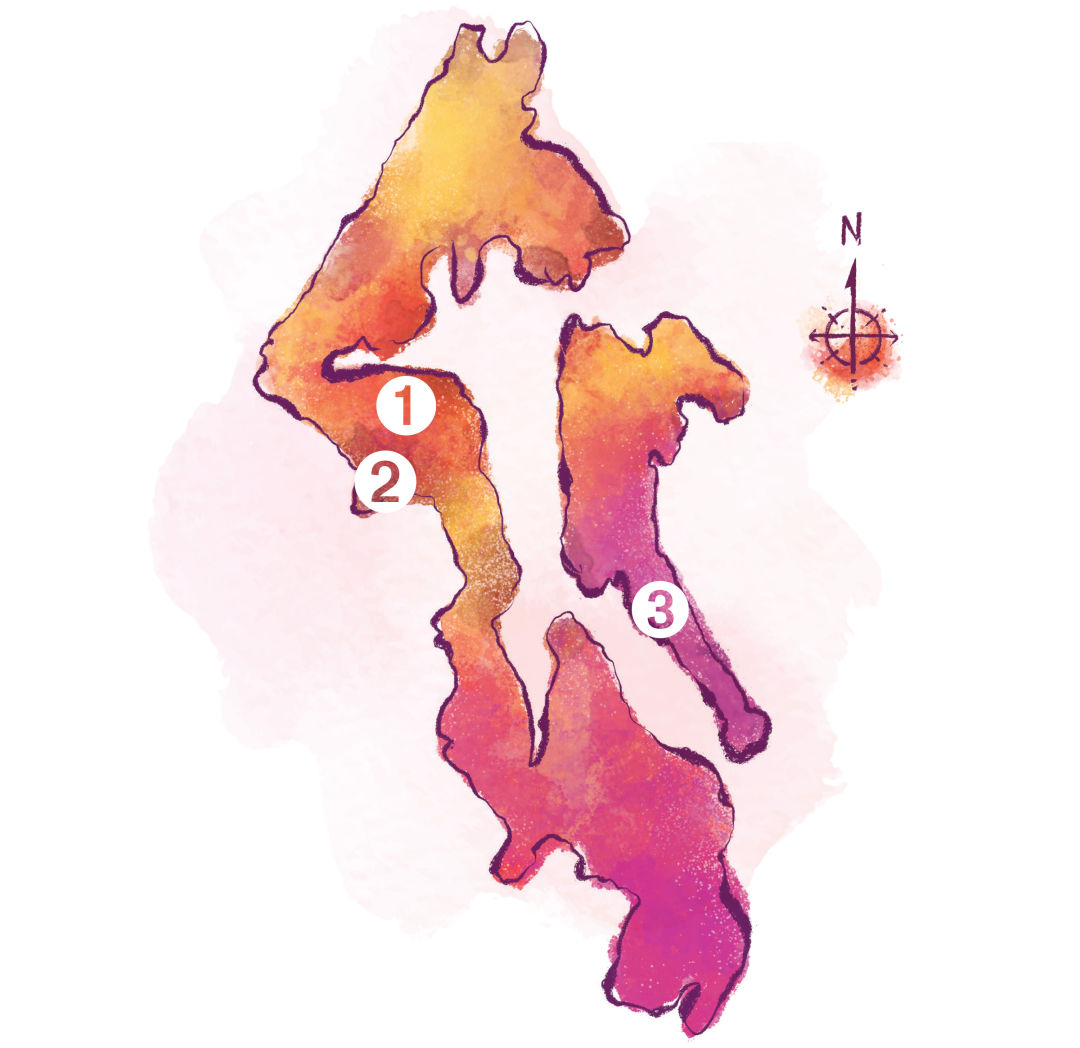
Essentials
1. Penn Cove Mussels
The famed mollusks harvested in one of the island’s protected bays taste best freshly shucked, simply steamed, and served aside garlic bread, as they do at Toby’s Tavern in the cute hamlet of Coupeville.
2. Fort Casey Historical State Park
One of Puget Sound’s classic nineteenth-century military forts, Casey touts the usual trio of lush parade grounds, a stately lighthouse, and old concrete battlements perfect for impromptu ghost hunting.
3. Matzke Fine Art and Design
Camano Island’s modest sculpture park fits more than 150 pieces into 10 acres, some artworks so intertwined with the landscape they look to have sprouted directly from the mossy ground.
Branching Out
Whidbey Island may be the only place where you can climb an old-growth tree 200 feet into the air—safely, at least.
Few childhood experiences, upon re-creation, live up to nostalgia; pillow forts merely induce claustrophobia in adults, and most of us outgrow the craving for s’mores. But from 200 feet up an old-growth Douglas fir, the chaotic Whidbey Island coastline visible below, tree climbing is way more fun than you remember.
AdventureTerra founder Leo Rosen-Fischer doesn’t think recreational tree climbing exists elsewhere in the country. Especially not the way he does it. Clients wear comfortable harnesses and ascend each line anchored to the trees using grippy tools. The squat-like movement turns every climber into a vertical inchworm, but it takes less than an hour to reach heady heights. The moderate workout isn’t even necessary; AdventureTerra offers a battery-powered ascender for those with limited mobility.
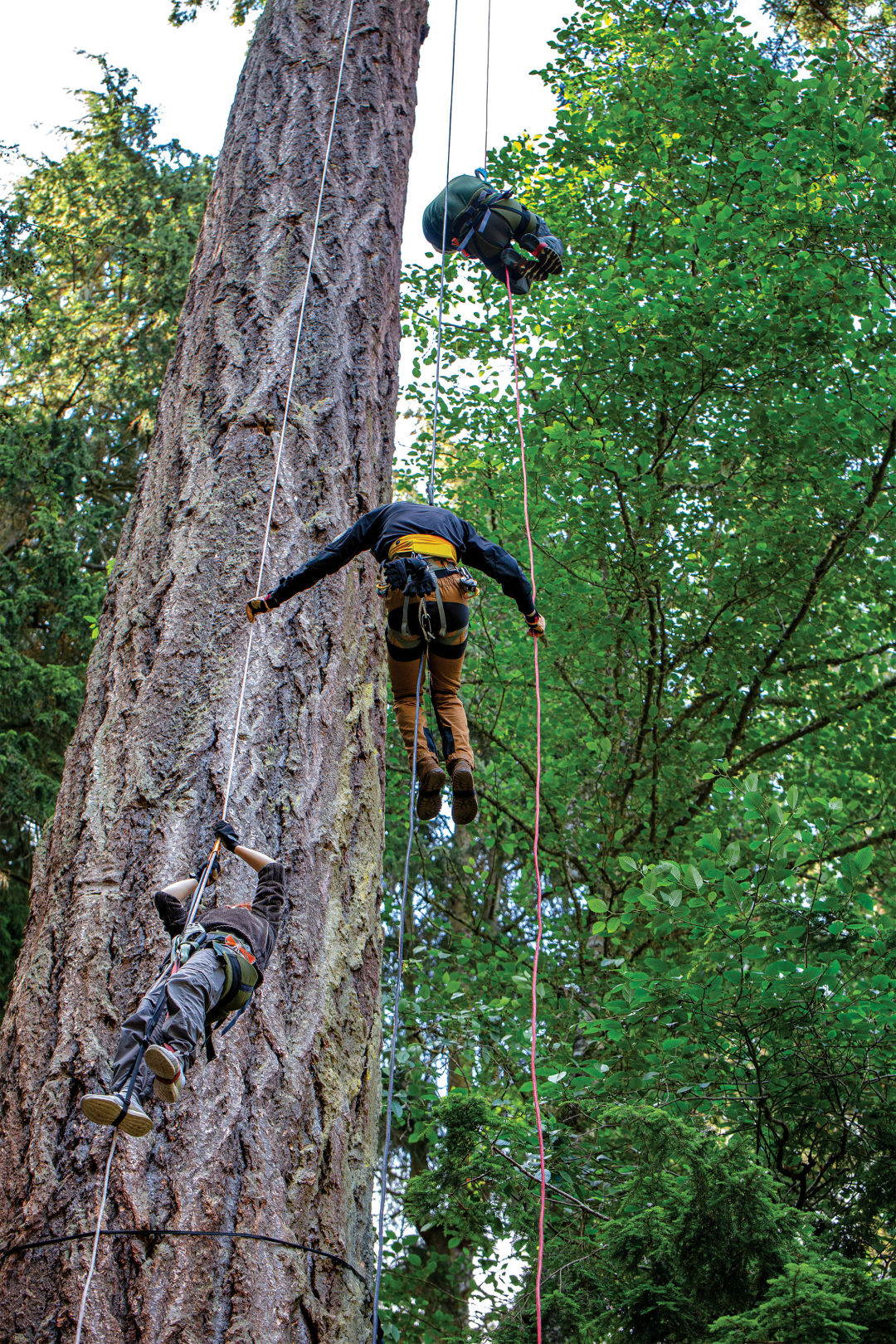
Like gym class, only greener (and easier): climbing the AdventureTerra way.
Image: courtesy adventureterra
A half-day session includes up to three Douglas fir ascents within Deception Pass State Park. Guide Rilen Anstett uses names bestowed by one of his grade-school clients: Pratt, the practice tree, sits just off the parking lot for instruction. Aqua, above the park’s north beach, stands more than 250 feet high and first sprouted from the ground more than 400 years ago—meaning she saw George Vancouver get turned around and name Deception Pass. The final climb, up the even older Hilly farther inland, includes a scramble up tree limbs near the top.
As we perch on branches in the canopy 230 feet in the air, bald eagles cruise at eye level and the fighter jets from Naval Station Whidbey roar by not much higher. We can spot the steel Deception Pass bridge from here while Anstett shares ecological facts, emphasizing how the ropes avoid harming the trees. Rosen-Fischer looks to expand his business into Oregon this summer, and might eventually hoist aerial tents into the air for off-the-ground camping experiences. It makes sense—once you’re 20 stories off the ground, who’d want to come down? adventureterra.com
DIY Summer Camp
Complete your childhood regression with a sleepaway experience on Whidbey and Camano Islands.
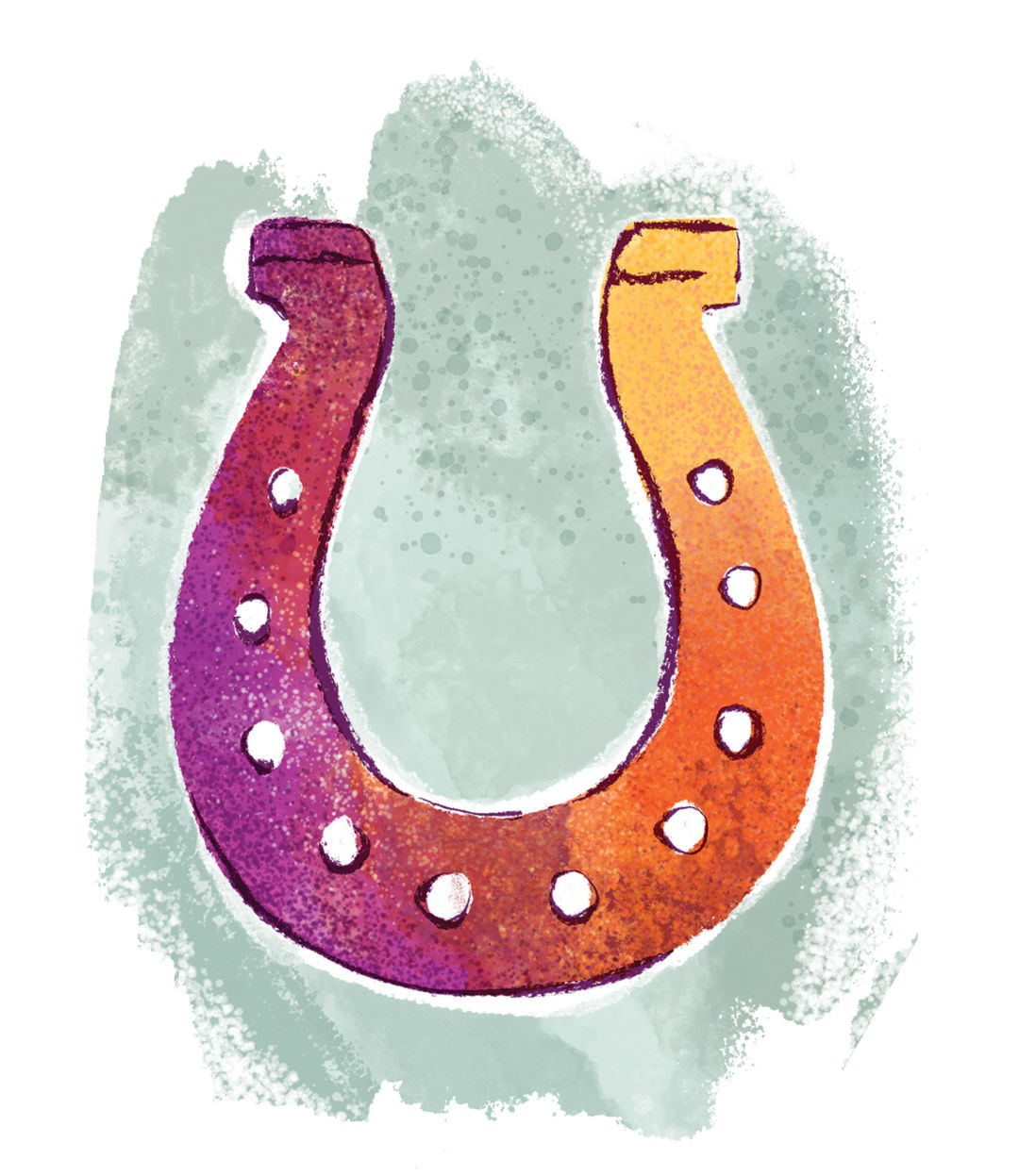
Horse-crazy kids never really grow out of it; Wildwood Farm lets guests bunk down near the stable and offers trail rides on the agrarian north end of Whidbey.
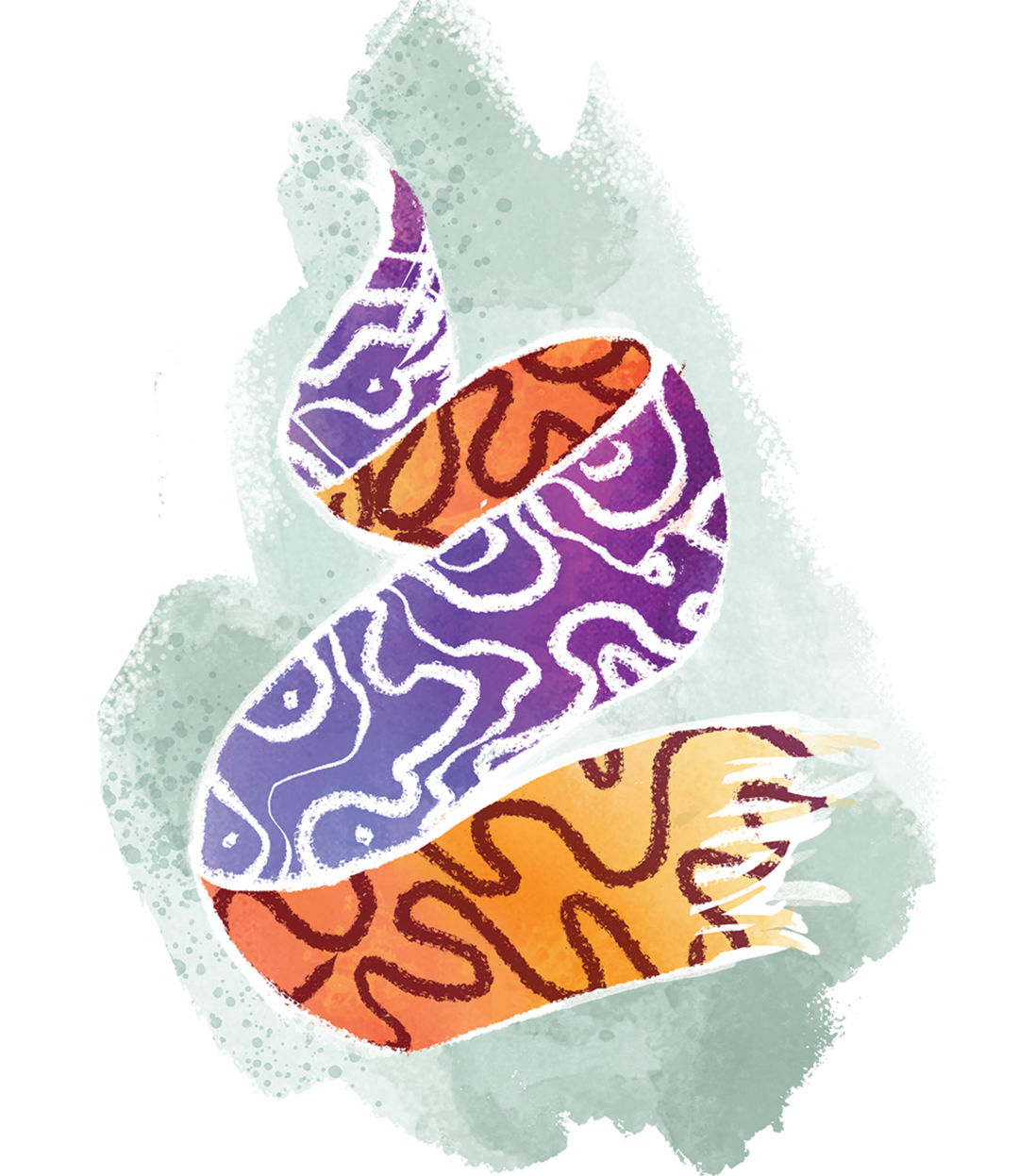
Forget lanyards: Arts and crafts go chic in silk-dyeing classes at Coupeville’s Marbley. Students learn marbling techniques and design their own groovy-patterned scarves in less than an hour.
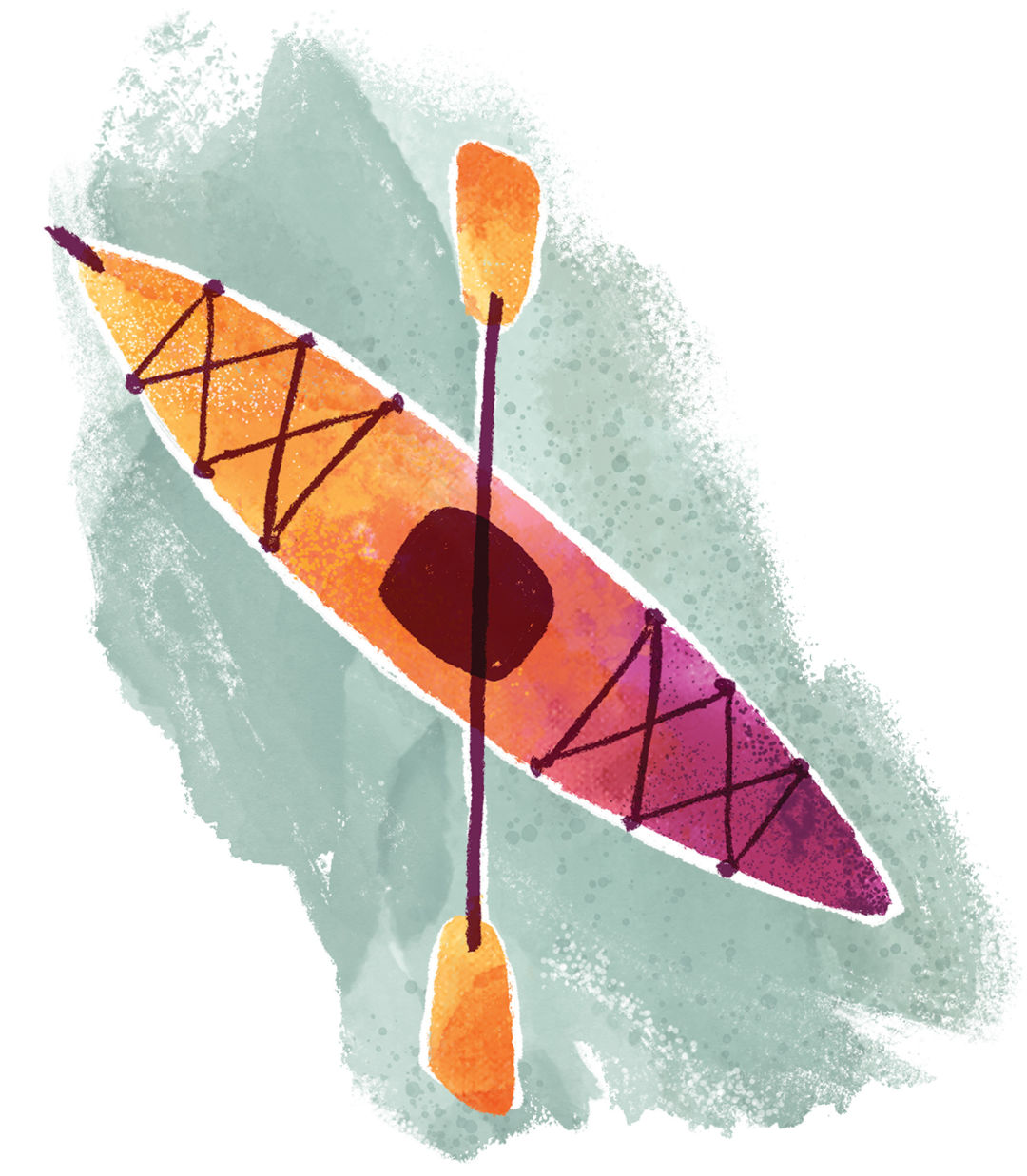
Most wood cabins at Cama Beach Historical State Park include bunk beds for the authentic summer vibe, all near a boathouse full of watercraft rentals and summertime naturalist programs.

